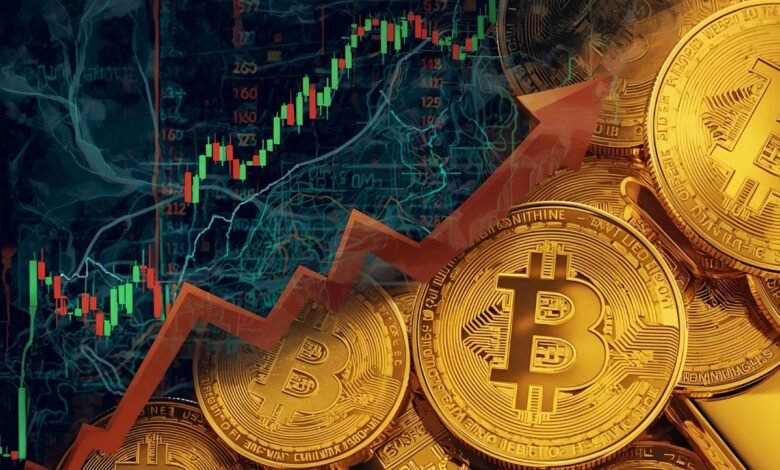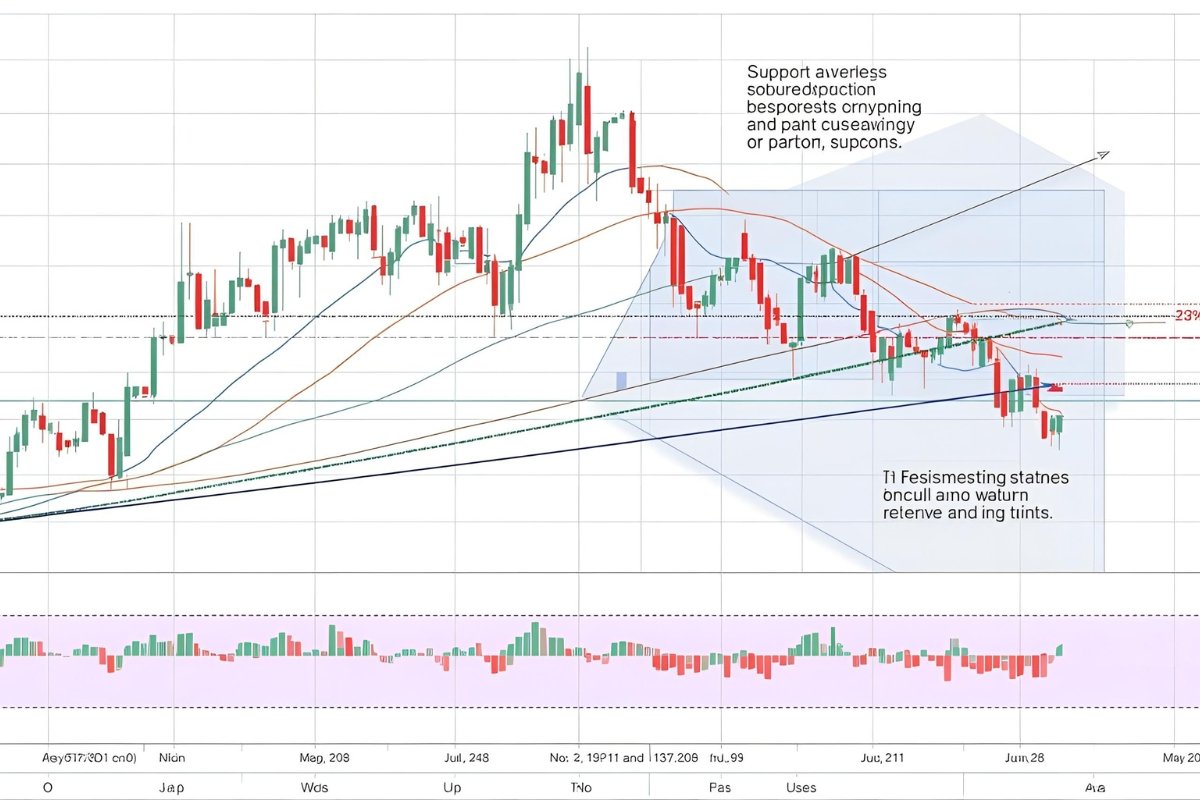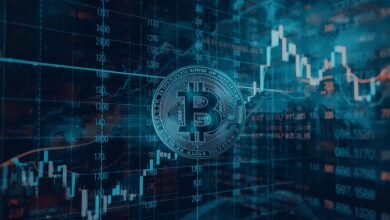
Bitcoin is experiencing a significant surge while gold prices tumbled to their lowest levels in what experts are calling the precious metal’s worst performance in half a decade. This dramatic shift represents more than just market volatility—it signals a potential transformation in how investors view safe-haven assets and where they’re choosing to park their capital during times of economic uncertainty.
The cryptocurrency market has been celebrating as Bitcoin climbed impressively, breaking through key resistance levels and reigniting discussions about digital assets as the future of wealth preservation. Meanwhile, the traditional haven of gold has suffered its most substantial decline since early 2020, leaving many investors questioning whether the age-old store of value is losing its luster in an increasingly digital economy. This simultaneous movement in opposite directions has created fascinating dynamics that reveal much about current investor sentiment, monetary policy expectations, and the evolving landscape of alternative investments.
The Great Divergence: Understanding the Bitcoin Rally
The recent Bitcoin price surge has captured headlines across financial media, with the leading cryptocurrency demonstrating remarkable strength amid broader market uncertainty. Digital asset enthusiasts have watched with renewed optimism as Bitcoin climbed steadily, erasing previous losses and establishing new momentum that suggests sustained bullish sentiment among crypto investors. This rally hasn’t occurred in isolation but rather represents a confluence of multiple factors that have converged to create ideal conditions for cryptocurrency appreciation.
Institutional adoption continues to play a pivotal role in Bitcoin’s ascent. Major financial institutions that once dismissed cryptocurrencies as speculative bubbles have increasingly embraced digital assets as legitimate components of diversified portfolios. The approval of Bitcoin exchange-traded funds in various jurisdictions has opened floodgates for traditional investors who previously lacked accessible entry points into the crypto market. These investment vehicles have channeled billions of dollars into Bitcoin, providing sustained buying pressure that has helped propel prices higher.
Furthermore, growing concerns about fiat currency devaluation and expansive monetary policies have driven investors toward decentralized alternatives. Bitcoin’s fixed supply of 21 million coins stands in stark contrast to unlimited government currency printing, making it increasingly attractive as an inflation hedge in an era of persistent price pressures. The cryptocurrency’s performance during periods of monetary uncertainty has begun to mirror characteristics traditionally associated with safe-haven assets, challenging gold’s centuries-old dominance in this category.
Gold’s Historic Tumble: Breaking Down the Decline
The gold market crash represents a stunning reversal for an asset class that has served as humanity’s ultimate store of value for millennia. Precious metal prices have plummeted by double-digit percentages, erasing months of gains and leaving gold investors reeling from unexpected losses. This dramatic decline marks the steepest fall since the market turbulence of 2020, when pandemic-related uncertainties sent precious metals on a rollercoaster ride.
Several interconnected factors have contributed to gold’s precipitous drop. Rising real interest rates have made non-yielding assets like gold less attractive compared to interest-bearing alternatives such as bonds and savings accounts. When Treasury yields climb while inflation expectations moderate, the opportunity cost of holding gold increases substantially. Investors who might have allocated capital to precious metals are instead finding better risk-adjusted returns in traditional fixed-income securities, creating significant selling pressure in the gold commodities market.
Additionally, a strengthening dollar has weighed heavily on gold prices. Since precious metals are priced in US currency, a robust greenback makes gold more expensive for international buyers, reducing global demand. The dollar index has rallied as the Federal Reserve maintains its commitment to elevated interest rates, creating headwinds for dollar-denominated commodities across the board. This currency dynamic has historically demonstrated inverse correlation with gold prices, and current market conditions perfectly illustrate this relationship.
The psychological shift among investors cannot be understated either. Gold has traditionally served as a crisis hedge and uncertainty buffer, but recent market behavior suggests investors are increasingly comfortable with risk assets despite geopolitical tensions and economic crosscurrents. This comfort level, combined with alternative options like cryptocurrencies, has diminished gold’s appeal as the default safety trade.
Digital Gold Versus Physical Gold: The New Investment Paradigm
The simultaneous rise of Bitcoin and fall of gold has reignited debates about which asset truly deserves the “digital gold” moniker that cryptocurrency advocates have long claimed for Bitcoin. This comparison extends beyond simple price movements to encompass fundamental questions about what constitutes a store of value in the 21st century. Both assets share characteristics that theoretically qualify them as wealth preservation vehicles, yet their recent performance suggests markets are reassessing these traditional assumptions.
Bitcoin’s technological advantages have become increasingly apparent to a digitally native generation of investors. The cryptocurrency offers portability, divisibility, and transferability that physical gold cannot match. Moving a billion dollars in Bitcoin requires nothing more than an internet connection and a digital wallet, whereas transporting equivalent value in gold demands armored vehicles, insurance, and secure storage facilities. These practical considerations matter enormously in an interconnected global economy where capital flows must occur at the speed of electronic networks.
However, gold maintains advantages that Bitcoin cannot replicate. The precious metal boasts thousands of years of historical acceptance as valuable, surviving the rise and fall of countless currencies and governments. Gold requires no electricity, no internet connection, and no complex technological infrastructure to maintain value. In scenarios involving complete technological failure or societal breakdown, physical precious metals would likely prove far more useful than encrypted digital ledger entries.
The market’s current preference for Bitcoin over gold may reflect optimism about technological continuity and financial system stability rather than a fundamental reassessment of each asset’s intrinsic properties. Cryptocurrency volatility remains substantially higher than gold price fluctuations, suggesting that recent capital flows favor growth potential over stability—a characteristic of risk-on rather than risk-off sentiment.
Institutional Money Flows: Following the Smart Money
Analyzing where institutional capital has migrated provides crucial insights into the Bitcoin-gold divergence. Large-scale investors, including hedge funds, pension funds, and sovereign wealth funds, wield enormous influence over market direction through their allocation decisions. Recent quarters have witnessed a notable shift in institutional preferences, with significant capital flowing from traditional safe havens into alternative assets that offer potential for capital appreciation alongside wealth preservation.
The cryptocurrency institutional adoption trend has accelerated dramatically. Major asset managers now offer crypto-focused funds, while traditional wealth management platforms have integrated digital asset custody services. This infrastructure development has legitimized cryptocurrencies in ways that grassroots enthusiasm alone could never achieve. When prestigious financial institutions publicly allocate portions of their portfolios to Bitcoin, they signal confidence that reverberates throughout investment communities.
Conversely, gold holdings among institutional investors have contracted. Exchange-traded funds backed by physical gold have experienced sustained outflows as investors redeemed shares. Central banks, historically the largest and most consistent gold buyers, have moderated their purchasing pace as foreign exchange reserves grow less dependent on precious metal backing. This institutional rotation away from gold has amplified the selling pressure created by individual investor decisions.
The regulatory environment has also evolved in ways that favor cryptocurrencies. Clearer guidelines around digital asset taxation, custody, and compliance have reduced uncertainty that previously deterred institutional participation. Meanwhile, gold faces no such regulatory developments—its status remains unchanged, which in a rapidly evolving financial landscape might actually represent a disadvantage against more dynamic alternatives.
Macroeconomic Factors Driving the Shift
Broader economic conditions have created the backdrop against which this Bitcoin-gold reversal has unfolded. Monetary policy decisions by central banks worldwide continue to shape investor behavior and asset allocation patterns. The Federal Reserve’s stance on interest rates, in particular, has profound implications for both cryptocurrencies and precious metals, though these impacts manifest through different channels.
Higher interest rates typically disadvantage non-yielding assets by increasing opportunity costs. However, the relationship between rates and asset prices proves more nuanced than simple inverse correlation. If elevated rates accompany strong economic growth and corporate earnings, risk assets, including cryptocurrencies, may thrive despite higher borrowing costs. Gold, lacking any yield or earnings potential, cannot benefit from this dynamic and instead faces purely negative pressure from rising rates.
Inflation dynamics present another crucial variable. While both Bitcoin and gold have been marketed as inflation protection vehicles, their actual performance during inflationary periods has varied considerably. Gold’s historical track record as an inflation hedge spans centuries, yet recent inflationary episodes have produced mixed results for precious metal investors. Bitcoin, with its much shorter history, has experienced both correlation and divergence with inflation, depending on the specific market circumstances.
Global economic uncertainty traditionally benefits safe-haven assets, yet current geopolitical tensions haven’t translated into gold buying as reliably as historical patterns might suggest. This breakdown in traditional correlations indicates that investors increasingly view risk through a different lens, one that sees technological innovation and decentralization as protective factors rather than threats. The younger demographics entering investment markets approach risk assessment differently than previous generations, and their preferences shape aggregate market behavior.
Technical Analysis: What the Charts Reveal
From a technical perspective, both Bitcoin and gold are painting starkly different pictures on price charts. Bitcoin technical indicators suggest bullish momentum with price action breaking above key moving averages and establishing higher lows that confirm uptrend continuation. Trading volume has increased alongside price appreciation, validating the move as genuine accumulation rather than low-volume speculation. Resistance levels that previously capped rallies have transformed into support zones, demonstrating conviction among buyers who have no intention of selling at current prices.
The cryptocurrency’s relative strength index readings indicate healthy momentum without reaching overbought extremes that typically precede corrections. This suggests room for additional upside before technical factors alone would warrant profit-taking or position reduction. Options markets show increasing interest in call options relative to puts, reflecting expectations for further appreciation among derivatives traders who often possess sophisticated market insights.
Gold’s technical picture tells an opposite story. Price has broken below critical support levels that held for extended periods, triggering stop-loss orders and forced selling that have accelerated the decline. Moving average crossovers have generated bearish signals that technical traders use as prompts to exit positions or establish short exposure. Trading volume spikes during down days indicate distribution rather than accumulation, meaning investors are actively reducing positions rather than viewing weakness as buying opportunities.
The gold-Bitcoin correlation has turned decisively negative, with the two assets moving in opposite directions with remarkable consistency. This inverse relationship suggests they’re increasingly viewed as substitutes within portfolio construction, with capital flowing from one to the other rather than both rising or falling together as would occur if they were truly fulfilling identical roles as safe havens.
Looking Ahead: Future Implications for Investors
The ramifications of this Bitcoin surge and gold decline extend far beyond immediate price movements. These trends potentially signify a generational transition in how humanity stores wealth and hedges against uncertainty. Digital natives who came of age with smartphones and internet connectivity approach investment with fundamentally different assumptions than previous generations, who witnessed gold’s reliability through multiple crisis cycles.
Portfolio diversification strategies may require reassessment in light of evolving asset class relationships. Traditional allocation models that prescribed specific percentages to gold as portfolio stabilizers might need modification to account for cryptocurrencies serving similar—or superior—functions for certain investors. The optimal mix between traditional precious metals and digital assets depends heavily on individual investor profiles, including age, risk tolerance, technological comfort, and belief systems about long-term societal trends.
Regulatory developments will critically influence whether current trends continue or reverse. Governments worldwide are grappling with how to approach cryptocurrencies, and policy decisions about taxation, permissible uses, and integration with traditional financial systems will determine whether digital assets can truly compete with gold’s established infrastructure. Conversely, gold faces minimal regulatory risk due to its ancient legacy but also lacks growth catalysts that might attract new capital.
The environmental considerations surrounding both assets have gained prominence as sustainability becomes an investment criterion. Bitcoin’s energy consumption through proof-of-work mining has drawn criticism, while gold mining operations cause significant environmental disruption. How these industries address sustainability concerns may influence future investor preferences, particularly among environmentally conscious younger demographics who will inherit and manage increasing wealth in the coming decades.
Conclusion
The simultaneous surge in Bitcoin prices alongside gold’s historic five-year drop represents more than mere market volatility—it signals a potential paradigm shift in how investors conceptualize safe-haven assets and wealth preservation. While gold’s millennia-long track record cannot be dismissed lightly, Bitcoin’s technological advantages and growing institutional acceptance have positioned it as a formidable alternative that resonates particularly with digitally native investors. The divergence between these two assets reflects broader themes, including monetary policy impacts, generational preferences, technological innovation, and evolving definitions of value in an increasingly digital world.
Investors navigating this landscape must recognize that both assets serve legitimate purposes within diversified portfolios, and the optimal allocation depends on individual circumstances rather than blanket recommendations. The dramatic recent price movements underscore the importance of understanding the unique factors driving each market and maintaining flexibility as economic conditions and investor preferences continue evolving. Whether Bitcoin’s surge and gold’s decline represent temporary aberrations or permanent shifts remains to be seen, but the conversation about digital versus physical stores of value has undeniably entered a new chapter that will shape investment strategies for years to come.
FAQs
Q1: Why is Bitcoin rising while gold is falling?
Bitcoin is rising due to increased institutional adoption, approval of cryptocurrency ETFs, concerns about fiat currency devaluation, and growing acceptance of digital assets as legitimate investments. Investor preferences toward risk assets and alternatives like cryptocurrencies. The divergence reflects changing investor sentiment about what constitutes a safe-haven asset in the digital age.
Q2: Should I sell my gold investments and buy Bitcoin instead?
This decision depends entirely on your individual financial situation, risk tolerance, investment timeline, and comfort with technology. Gold remains a time-tested store of value with thousands of years of historical acceptance, while Bitcoin offers growth potential but comes with significantly higher volatility and technological dependencies.
Q3: Is Bitcoin really “digital gold” or just a speculative asset?
Bitcoin shares some characteristics with gold, including limited supply, independence from government control, and potential to serve as a store of value, which is why it earned the “digital gold” nickname. However, Bitcoin’s extreme price volatility, relatively short history, and dependence on technological infrastructure distinguish it significantly from physical gold.
Q4: How low could gold prices go during this decline?
Predicting exact price floors is impossible, but technical analysts watch key support levels, including production costs for mining operations, which create natural price floors since miners will curtail production if prices fall below profitability thresholds. Historical support zones and psychological price levels like round numbers also influence where buying pressure might emerge.
Q5: Will gold ever recover, or has Bitcoin permanently replaced it?
Gold has survived countless challenges over thousands of years and has repeatedly recovered from significant declines. While Bitcoin offers technological advantages, gold maintains unique properties, including no dependence on electricity or internet, universal physical acceptance, and deep historical trust that cannot be replicated by any digital asset.










